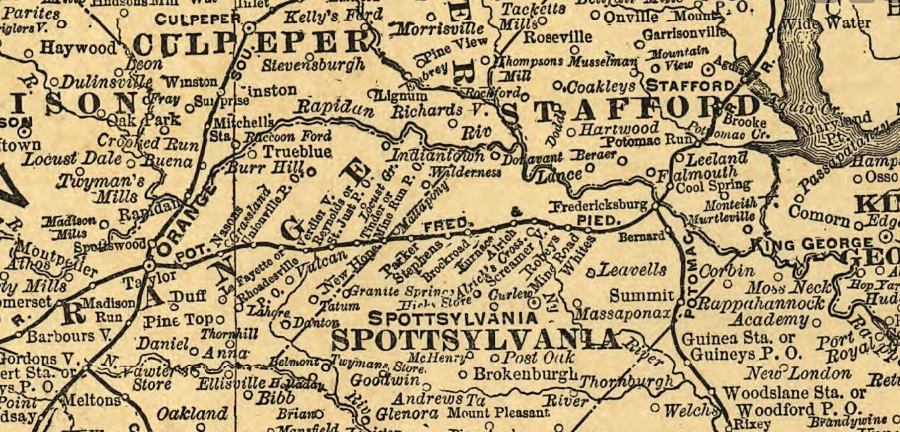
Fredericksburg built a railroad to Gordonsville
Source: Library of Congress, Indexed county and railroad pocket map and shippers guide of West Virginia (Rand McNally and Company, 1898)

Fredericksburg built a railroad to Gordonsville
Source: Library of Congress, Indexed county and railroad pocket map and shippers guide of West Virginia (Rand McNally and Company, 1898)
In the competition to grow into a major port city, Fredericksburg lost its race with Alexandria. Alexandria extended its network of turnpikes and railroads into the Piedmont west of Fredericksburg and captured the trade from that hinterland first.
The Orange Turnpike was completed to Orange before 1820, but the Rappahannock Canal and the Fredericksburg and Gordonsville Railroad were built too late. Both Fredericksburg-focused transportation projects stopped far short of the eastern base of the Blue Ridge, while Alexandria extended its tentacles through the mountains to the Shenandoah Valley prior to the Civil War.
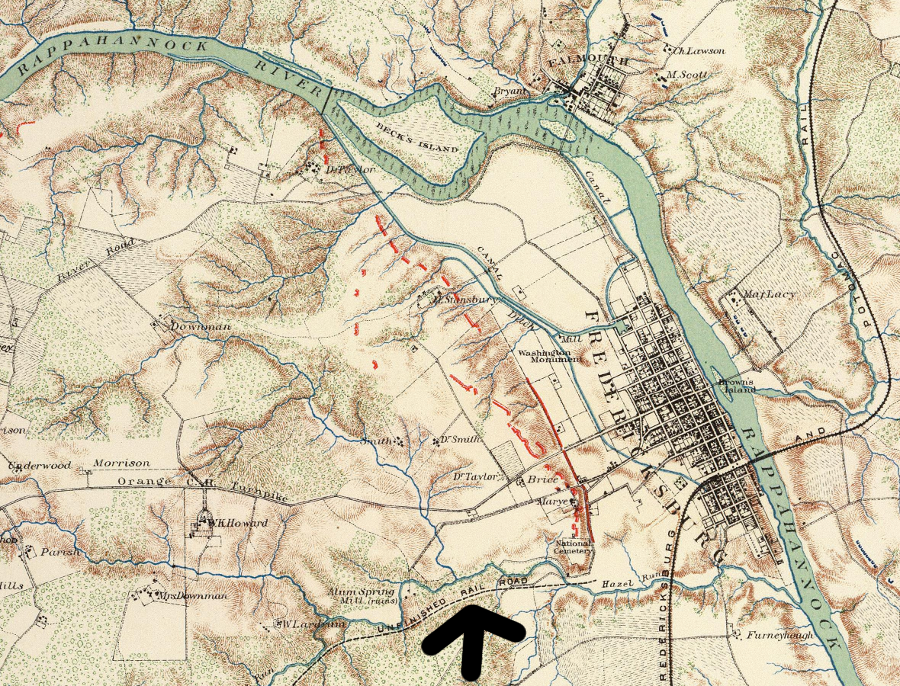
the planned railroad linking Fredericksburg and Gordonsville was graded but unfinished prior to the Civil War
Source: David Rumsey Map Collection, Fredericksburg. Prepared by Bvt. Brig. Gen. N. Michler (1867)
The General Assembly chartered the Fredericksburg & Gordonsville Railroad Company in 1853.1

the Fredericksburg & Gordonsville Railroad was designed to compete with the Orange Turnpike
Source: Library of Virginia, A map of the rail roads of Virginia (1858)
The Bureau of Public Works purchased 30% of the stock, since Virginia was building railroads and other transportation projects as public-private partnerships. Other investors had to finance the remaining 70$ of the projected $460,000 costs, and the city of Fredericksburg used municipal funds to purchase a substantial share.
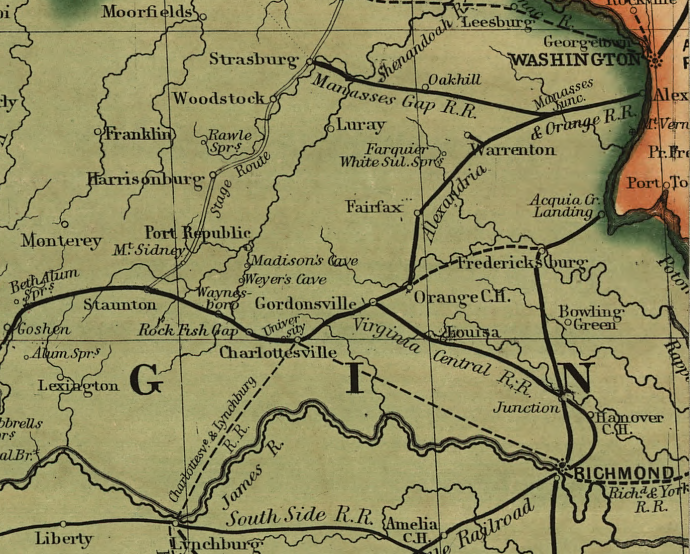
the route planned for the Fredericksburg and Gordonsville Railroad
Source: Library of Congress, Railroad map of the eastern, western and northern states, and Canada (1859)
Construction ended due to the Panic of 1857. By that time, 18 miles along the 38-mile route had been cleared of trees and graded to create a flat grade.1
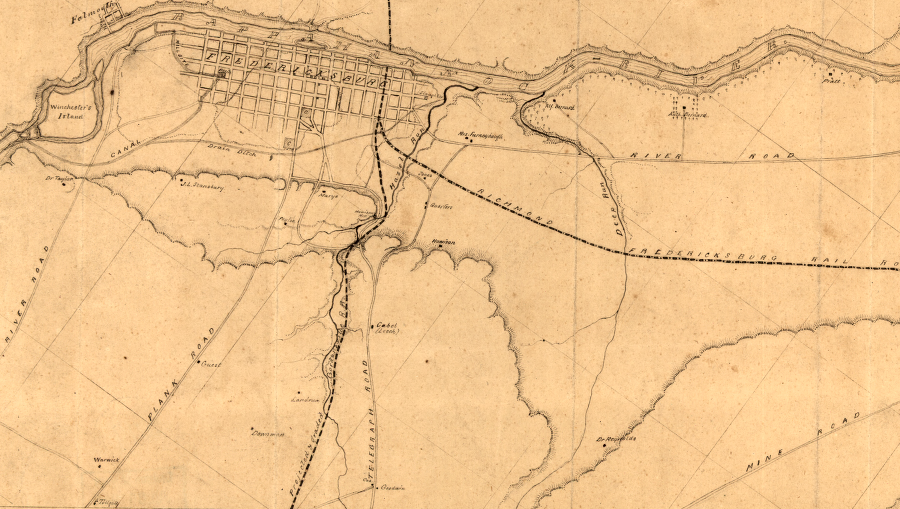
the Fredericksburg & Gordonsville Railroad was graded but unfinished in 1862
Source: Library of Congress, Map of Fredericksburg, Va., and vicinity (1862)
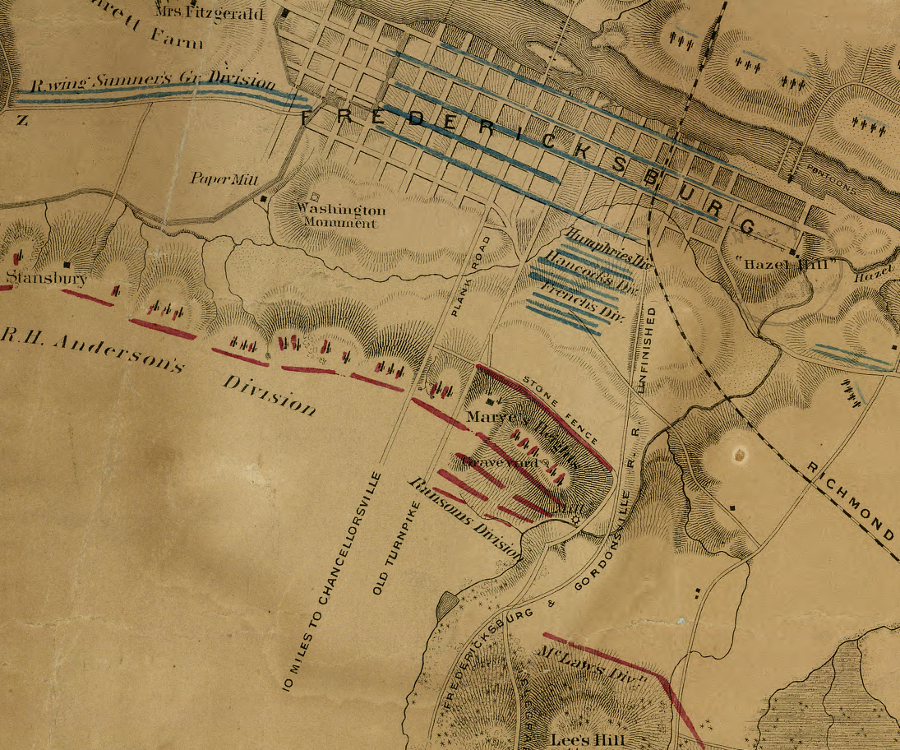
during the 1862 battle of Fredericksburg, the Fredericksburg & Gordonsville Railroad cut through Confederate lines
Source: Library of Congress, Map of the battle field of Fredericksburg, Dec. 13, 1862
The unfinished railroad stretched west to Parker's Store, near the boundary of Spotsylvania and Orange counties. Its path ran through the Wilderness, an area of young trees regrowing after forests had been cleared to make charcoal for Catharine's Furnace. The iron-making had ceased there in the 1840's, so the railroad expected to profit from hauling agricultural products and passengers rather than pig iron.2
At the start of the Civil War in 1861, there were no rails on the path of the Fredericksburg and Gordonsville Railroad that had been carved through the woods, so no tracks for trains to use. Union and Confederate commanders did not consider the unfinished railroad to be a strategic objective to control, in contrast to the Orange and Alexandria Railroad at Manassas. River fords, plank roads, and the Orange Turnpike west of Fredericksburg shaped troop movements, rather than the railroad.
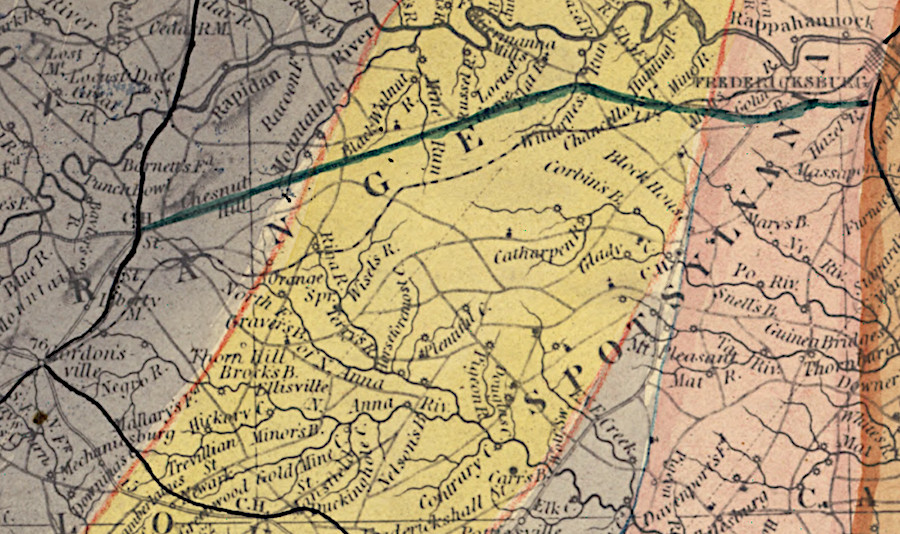
in 1862, the Fredericksburg and Gordonsville Railroad was mapped as a plank road (green line) rather than as a railroad (black lines)
Source: Library of Congress, Geological map of the state of Virginia (Thomas S. Risgeway, 1862)
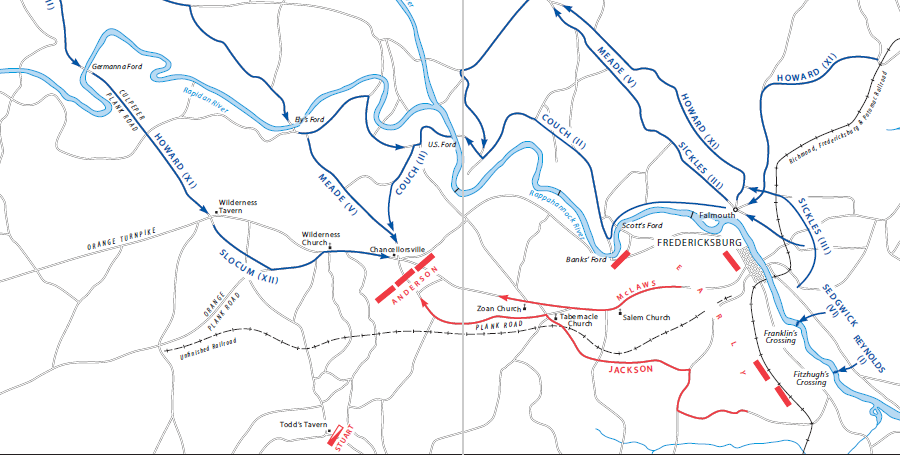
the unfinished Fredericksburg and Gordonsville Railroad was a minor element in the military actions during Civil War
Source: The U.S. Army Campaigns of the Civil War, The
Chancellorsville Campaign, January - May 1863 (Map 1)
During the 1863 Battle of Chancellorsville, Stonewall Jackson's flank march led him past Catharine's Furnace. Union forces attacked his rear guard where the railroad workers had dug a path through a local hill and captured most of the 23d Georgia regiment, but the railroad was largely irrelevant. Jackson's scouts must have used it, but he marched his troops on other narrow trails and the wider roads in order to get around Hooker's right flank.3
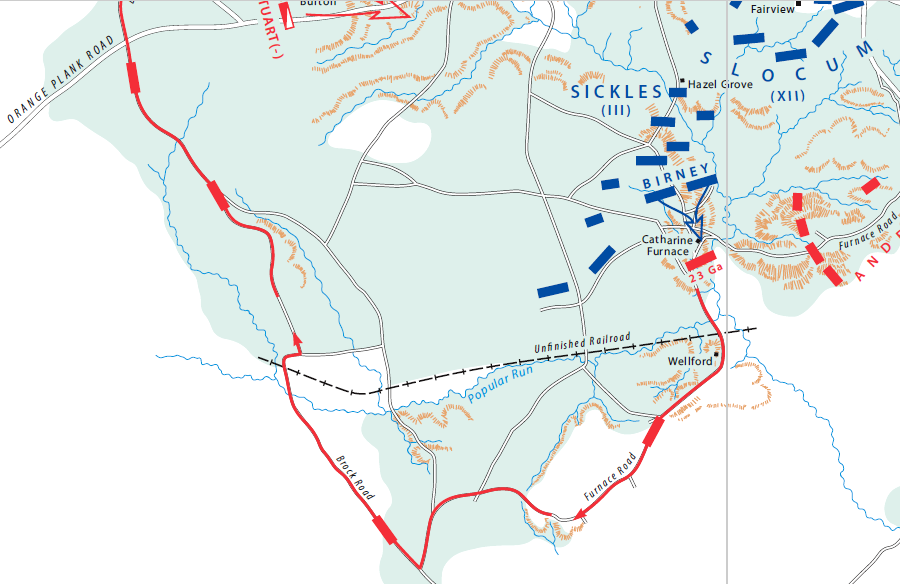
to attack Hooker's right flank at Chancellorsville, Stonewall Jackson marched his troops on Furnace and Brock roads because the railroad path was too narrow
Source: The U.S. Army Campaigns of the Civil War, The
Chancellorsville Campaign, January - May 1863 (Map 3)
The unfinished railroad cut did play a role in 1864 during The Wilderness battle. On the second day of the battle, A. P. Hill's outnumbered Confederate troops were being pushed back by Union forces commanded by General Winfield Scott Hancock. Before the Confederate lines were broken, General James Longstreet's reinforcements arrived via the Plank Road. He used the unfinished railroad cut to align four Confederate brigades and catch Hancock's troops by surprise, rolling them up "like a wet blanket" and helping block the Union advance.4
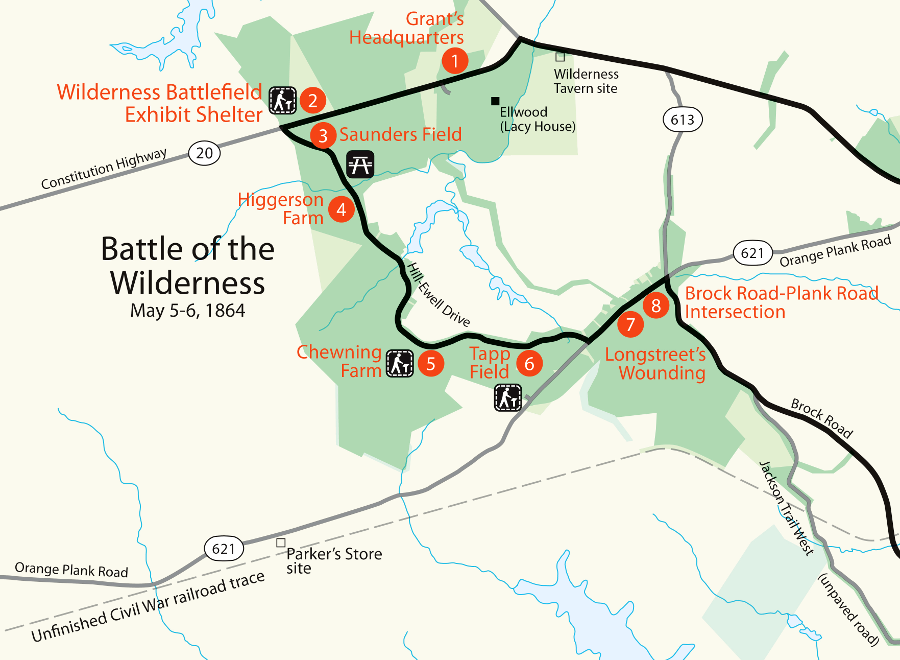
General Longstreet used the railroad cut to organize four Confederate brigades before attacking Union forces on May 6, 1863 on the second day of The Wilderness
Source: National Park Service, Wilderness Battlefield
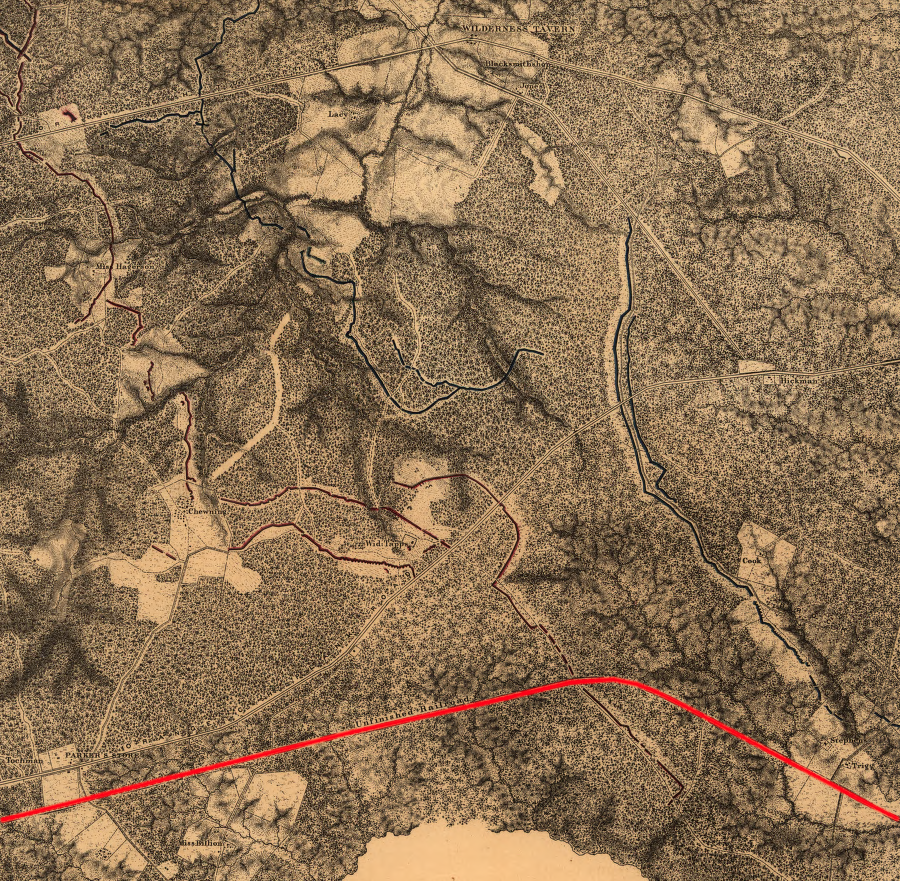
the unfinished Fredericksburg & Gordonsville Railroad helped shape troop movements in May, 1864
Source: Library of Congress, Wilderness Battlefield (by Nathaniel Michler, 1867)
After the Civil War, New York investors purchased the Fredericksburg and Gordonsville Railroad. Track was installed on the 18 miles of completed grade as far west as Parker's Store. In another period of economic recession ("panic"), the company went through bankruptcy in 1873 and was reorganized as the Fredericksburg, Orange and Charlottesville Railroad.5
The new owners failed to fulfill their promise to build the additional 20 miles of track required to link the end of the line at Parker's Store to the Washington City, Virginia Midland and Great Southern Railroad (Virginia Midland) at Orange. The state reclaimed ownership based on the terms of the mortgage, and in 1876 the railroad was reorganized again as the Potomac, Fredericksburg & Piedmont (PF&P). A judge declared:6
The existing 18 miles of railroad between Fredericksburg and Parker was converted from standard gauge (4' 8.5" between rails) to narrow gauge (3' between rails). Narrow gauge railroads were less expensive to operate and especially to construct. The remaining 20 miles to Orange was bult as a narrow gauge line, and service to Orange started on February 26, 1877.
The Washington City, Virginia Midland & Great Southern Railroad at Orange (built originally as the Orange and Alexandria Railroad) was a standard gauge line. The Richmond, Fredericksburg and Potomac (RF&P) in Fredericksburg was also standard gauge. All freight and passengers using the Potomac, Fredericksburg & Piedmont Railroad had to be transferred to different rail cars at either end of the line.
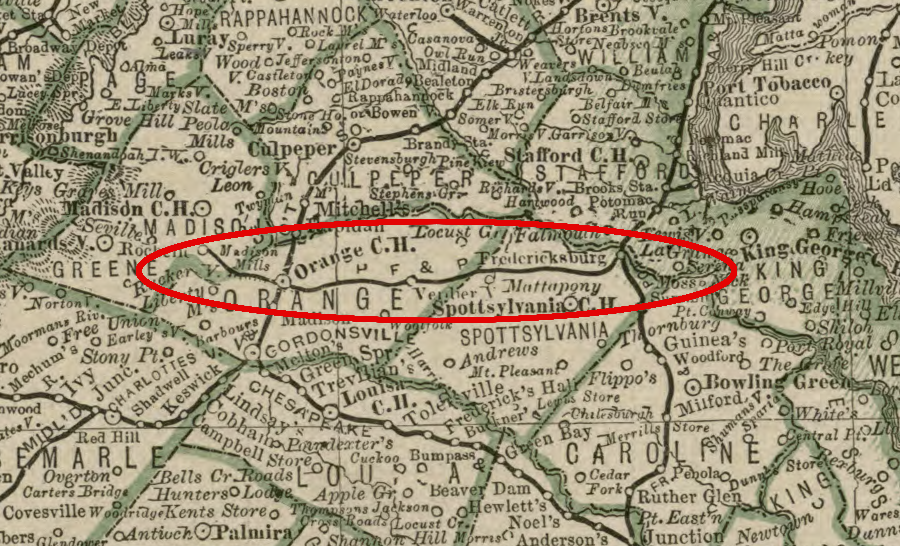
in 1879, Fredericksburg had a railroad connection to Orange Court House in the Piedmont
Source: Library of Congress, Rand, McNally & Co.'s Virginia and West Virginia (Rand, McNally and Company's business atlas, 1878-79)
The Royal Land Company gained control of the Potomac, Fredericksburg & Piedmont Railroad between 1876-88. It planned to build the Shenandoah Valley and Ohio Railroad west of Orange across the Blue Ridge via Swift Run Gap, to access timber and coal on 155,000 acres owned in Rockingham and Pendleton counties. The potential for expansion to Pittsburg was also part of the company's planning.
The company also planned to extend the Potomac, Fredericksburg & Piedmont Railroad east of Fredericksburg to a port on the Potomac River at Mathias Point. That extension would provide a direct route for shipping the company's timber and coal to market.
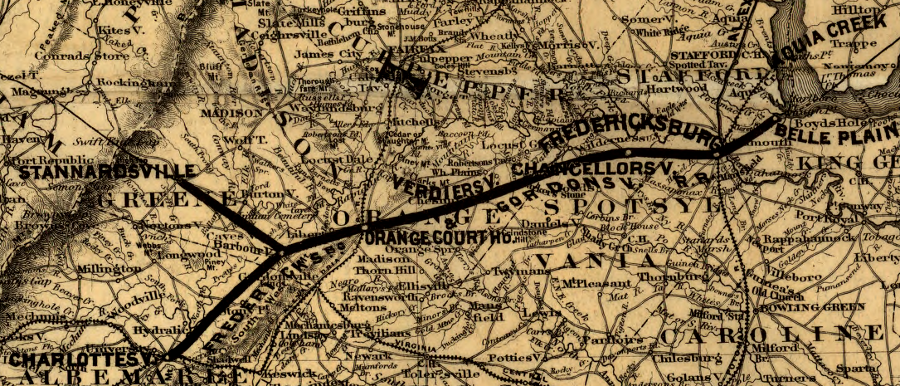
the Potomac, Fredericksburg & Piedmont Railroad could have been extended east to the Potomac River
Source: Library of Congress, Map showing the Fredericksburg & Gordonsville Rail Road of Virginia (1869)
Mathias Point was an attractive location because the Potomac River channel was 23' deep, while the Rappahannock River at Fredericksburg was less than 10' deep at low water. In addition, the Baltimore and Ohio Railroad had a branch line that started at Pope's Creek, directly across from Mathias Point on the Maryland side of the Potomac River.7

the Royal Land Company proposed to build a "Shenandoah Valley and Ohio Railroad" west of Orange, and to extend the Potomac, Fredericksburg & Piedmont Railroad from Fredericksburg to Mathias Point
Source: ESRI, ArcGIS Online
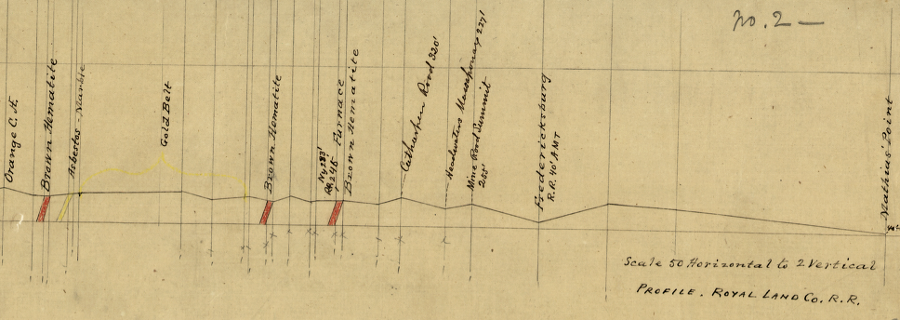
the Royal Land Company planned to extend the narrow gauge Potomac, Fredericksburg & Piedmont Railroad to a sea-level port
Source: Library of Congress, Profile, Royal Land Co. R.R. (188_?)
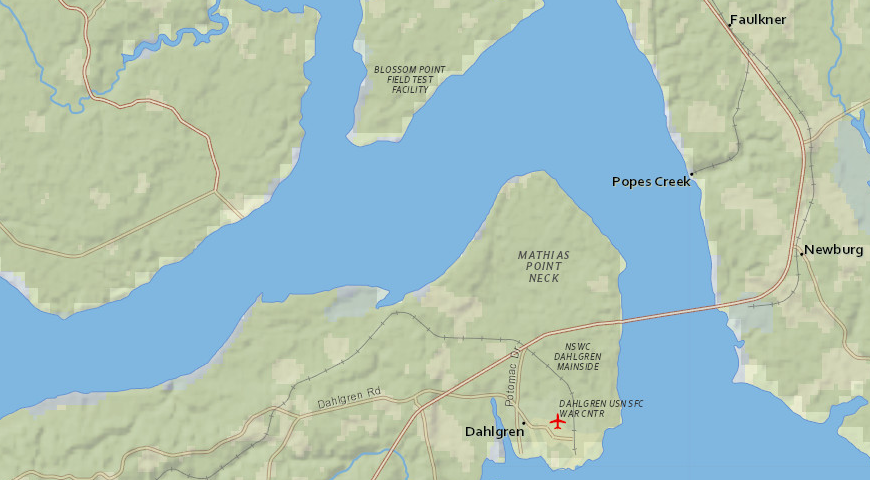
Mathias Point was across the Potomac River from the Baltimore and Ohio Railroad's landing at Pope's Creek, Maryland
Source: ESRI, ArcGIS Online
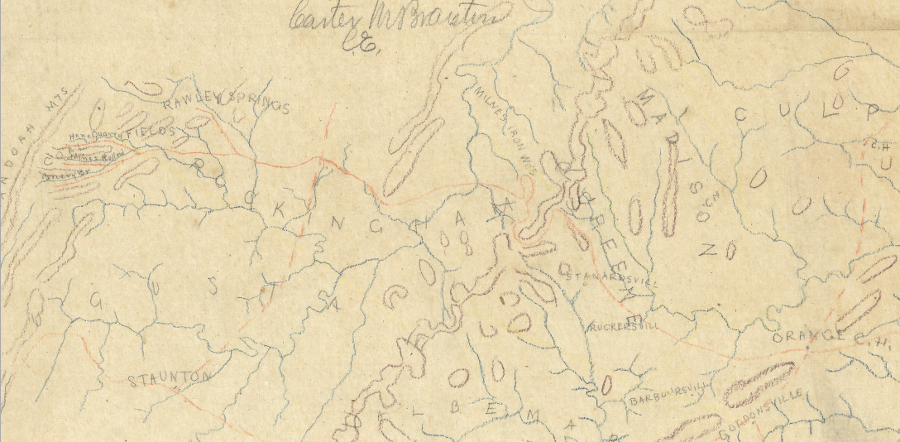
the Royal Land Company planned to build the Shenandoah Valley and Ohio Railroad west to its timberlands and coal fields
Source: Library of Congress, Map of Royal Land Company's railroad (narrow gauge) from their anthracite coal fields to deep water (187_?)
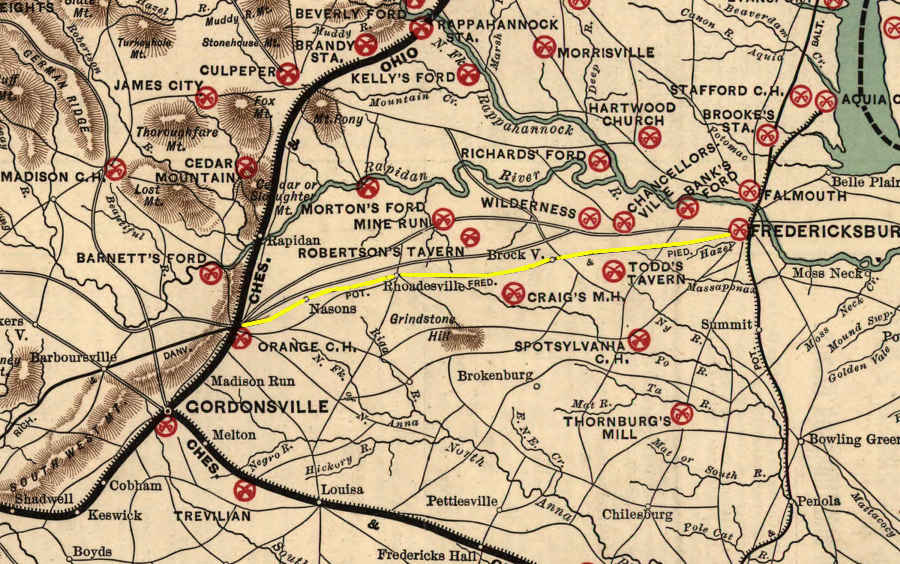
in 1895, the Fredericksburg and Gordonsville Railroad provided rail service between Fredericksburg and Orange (but not to Gordonsville)
Source: Library of Congress, Map showing the location of battle fields of Virginia (by Chesapeake and Ohio Railway Company, 1895)
The Pittsburg-based Royal Land Company soon lost control of the Potomac, Fredericksburg & Piedmont Railroad to Philadelphia investors. Until the automobile and trucks diverted traffic in the 1920's, the narrow gauge line was financially viable but was never a major money-maker.
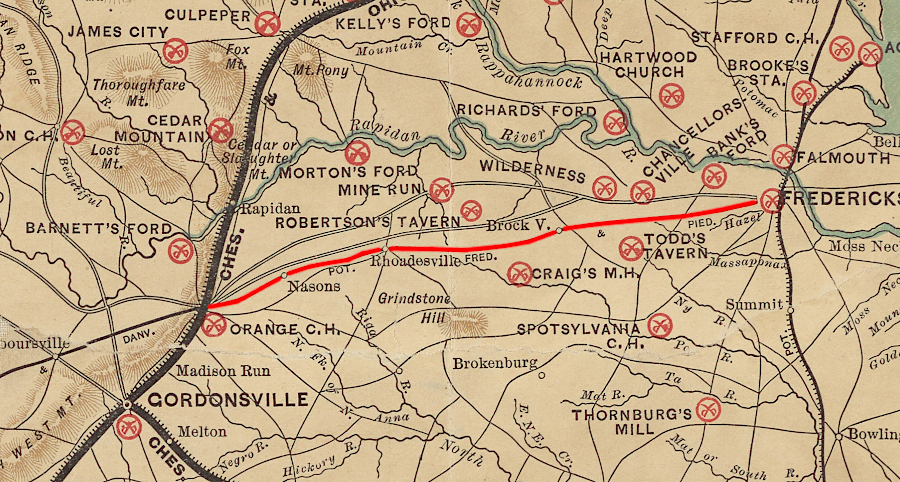
Potomac, Fredericksburg & Piedmont (PF&P) Railroad
Source: New York Public Library, Map showing the location of battle fields of Virginia (1891)
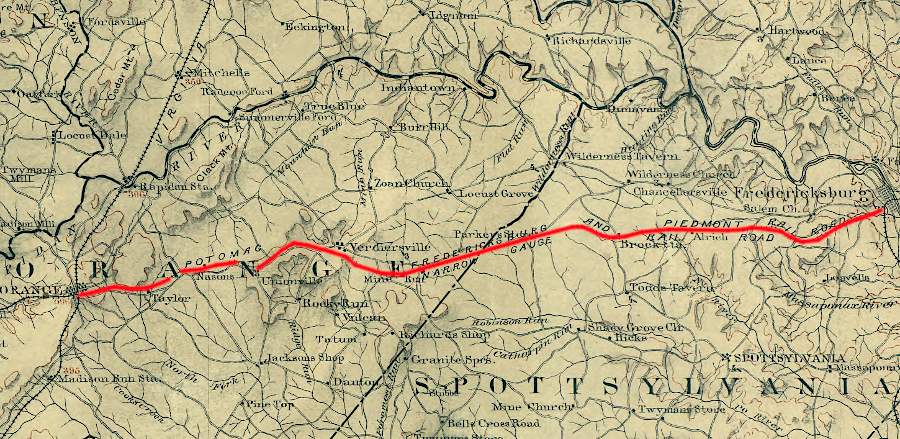
Potomac, Fredericksburg & Piedmont (PF&P) Railroad in 1894
Source: Library of Congress, Map of northern Virginia (1894)
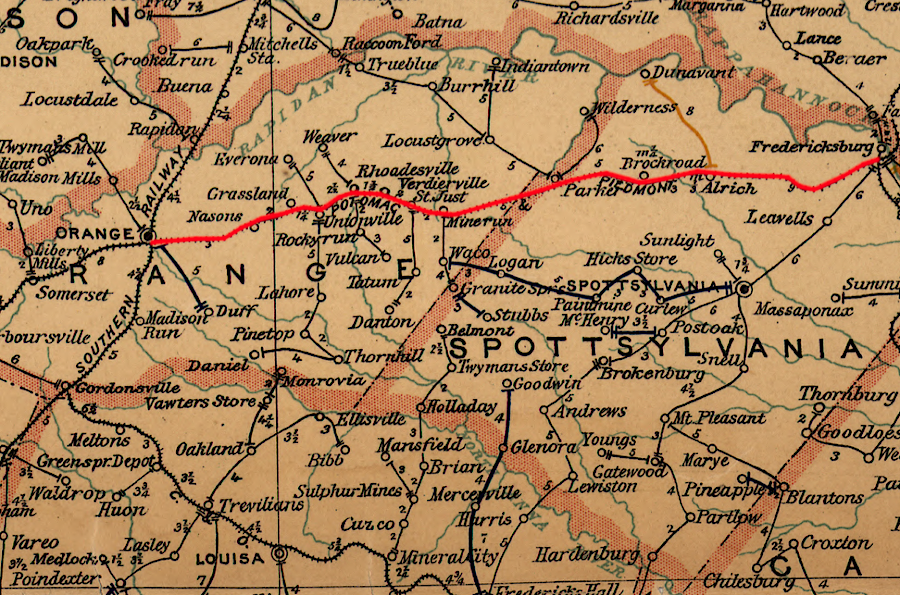
Potomac, Fredericksburg & Piedmont (PF&P) Railroad in 1896
Source: Library of Congress, Post route map of the state of Virginia and West Virginia (1896)
The narrow-gauge track limited any option of diverting traffic off the Southern Railway or the Richmond, Fredericksburg and Potomac Railroad. The number and size of trains was low on what became known locally as the "Poor Folks and Preachers" railroad. Without an expectation of higher profits, it was never expanded beyond the 38-mile stretch from Fredericksburg to Orange.8

the narrow gauge Potomac, Fredericksburg & Piedmont Railroad operated between Fredericksburg-Orange between 1876-1926
Source: Library of Congress, Map of northern Virginia (1894)
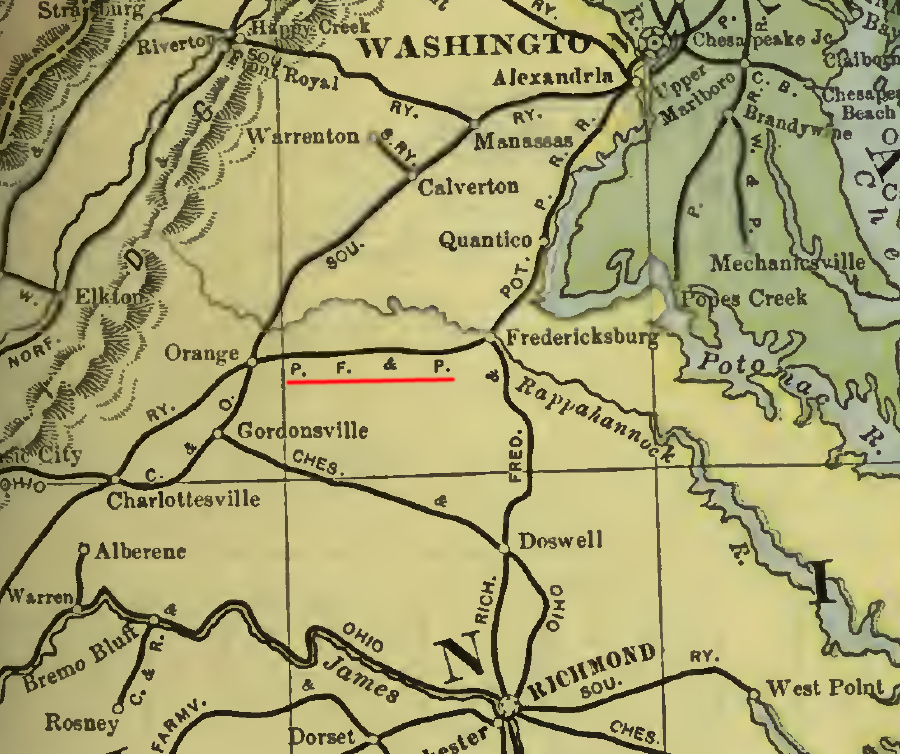
Poors Manual of Railroads identified the route of the Potomac, Fredericksburg & Piedmont Railroad in 1901
Source: Poors Manual of Railroads 1901, Railroad Map of the United States - Delaware, Maryland, Virginia and West Virginia (after p.128)
In 1925, locals purchased the railroad to prevent abandonment and conversion of the equipment into scrap. The new owners named it the Orange and Fredericksburg Railway. That undercapitalized, unprofitable operation lasted only a year.
After another sale, the line was renamed the Virginia Central Railroad, recycling the name of a line completed before the Civil War between Richmond and Staunton. The new Virginia Central advertised services on the "Battlefield Route." Despite the railroad's name, it had no relationship to the earlier Virginia Central railroad that was a key transportation link for moving Confederate supplies and troops north from Richmond.
The new Virginia Central Railroad finally converted the Potomac, Fredericksburg & Piedmont's narrow gauge track to standard gauge. That enabled the line to interchange freight and passenger cars with the Richmond, Fredericksburg and Potomac (RF&P) Railroad in Fredericksburg. It also interchanged with the Southern Railroad in Orange, where a new station was built 1926.
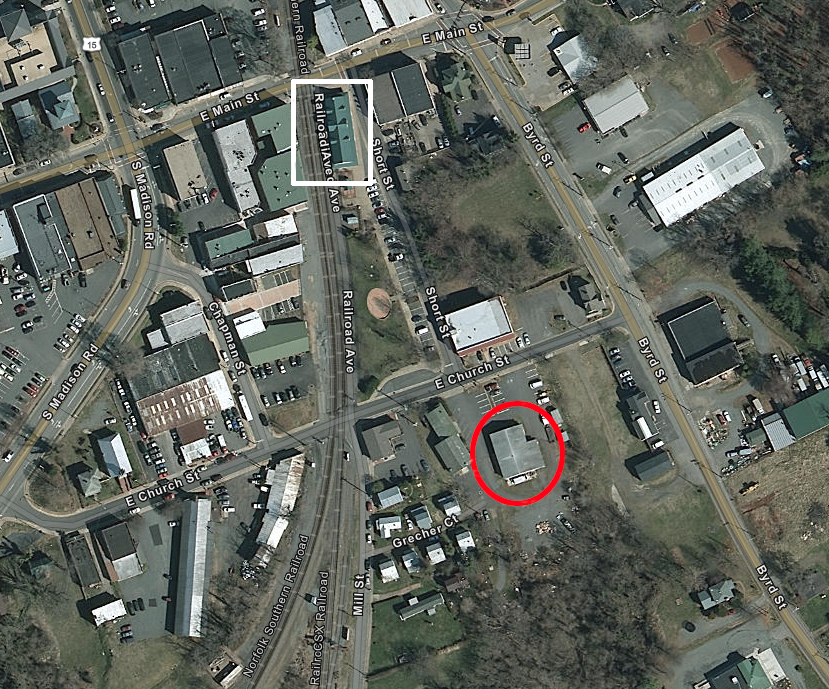
the Virginia Central station built in 1926 (red circle) still survives in Orange, south of the active station today (white rectangle)
Source: ESRI, ArcGIS Online
The farms and timberland between Orange and Fredericksburg generated little traffic. Without quarries or factories, there was little need for freight cars. The Virginia Central Railroad's most profitable operations were moving cars from the RF&P to industrial customers on the western side of Fredericksburg, using the mile of track on the railroad's far eastern edge.
During the 1930's, the railroad was still called the "Narrow Gauge" despite the conversion to wider tracks.
There was at least one fatal accident on the Virginia Central Railroad. In 1928, a gang of workers gathered on a handcar that was pushed by the motorized car. The handcar derailed and was smashed by the car behind it. One worker died at the scene, and five were injured.9
Most "Narrow Gauge" railroad operations ended in 1938 as a result of the Great Depression. On the west end, a stub in the Town of Orange was used until the 1980's.
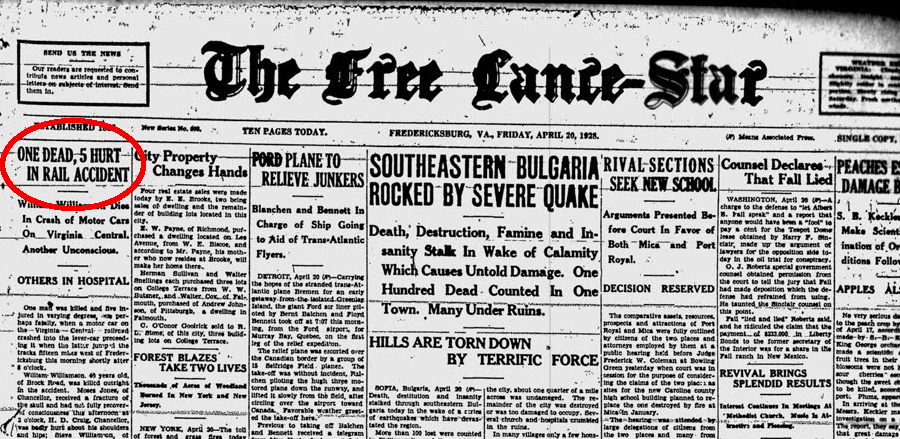
the Fredericksburg paper reported the fatal accident in 1928 on the Virginia Central Railroad
Source: Spotsylvania Memory, Death on the Virginia Central
On the east end, a one-mile portion in Fredericksburg remained active to provide switching and siding service for industrial customers, connecting them to the Richmond, Fredericksburg and Potomac Railroad (now CSX) for long-distance transportation. There were few profits in that business, but the City of Fredericksburg wanted to keep the industrial businesses and the taxes they generated. In 1967, the owner of the Virginia Central sold the railroad to the city.
In 1975, the city found a buyer. His business was primarily providing income tax shelters to wealthy clients, and owning a railroad would facilitate greater tax deductions. Fredericksburg sold the railroad to Railvest for a nominal amount, after getting a commitment from the company to continue switching railcars for the industrial customers. The city retained ownership of the land, and Railvest placed several hundred boxcars into the national freight car pool as tax shelters.
Railvest collapsed in 1978 amid accusations of financial misdeeds. Company employees and the Richmond, Fredericksburg and Potomac (RF&P) Railroad refused to move railcars for the industrial customers for several weeks until they were paid.
The city managed to sell the railroad once last time in 1979. It was sold once again to a buyer who planned to use it for the financial advantages of freight car leasing, rather than for making a profit through railroad operations. In 1983, when Central Management was faced with the prospect of paying for repairs to the wooden trestle over Hazel Run, it closed down the railroad.10
The eastern end in Fredericksburg is now incorporated in the Virginia Central Railway trail at Alum Springs Park. The Virginia Central's railyard was developed into Cobblestone Square.11
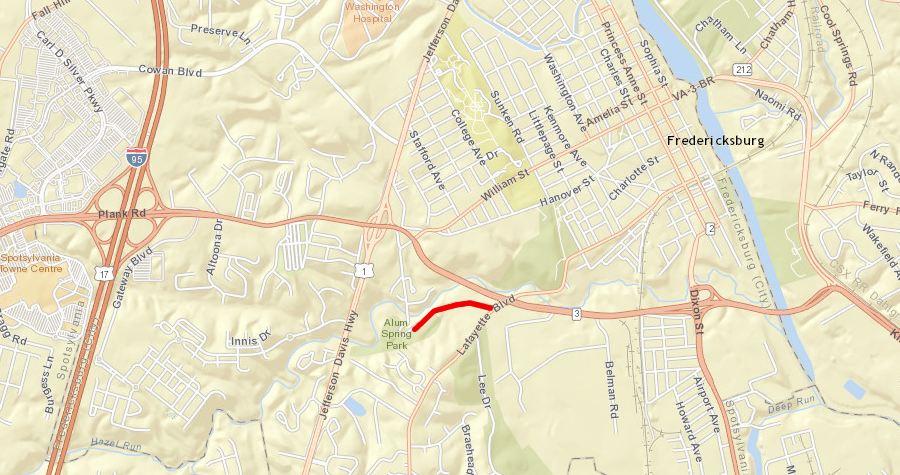
Alum Springs Road (red line) and a trail in the park mark a segment of the route of the old Fredericksburg and Gordonsville Railroad
Source: ESRI, ArcGIS Online
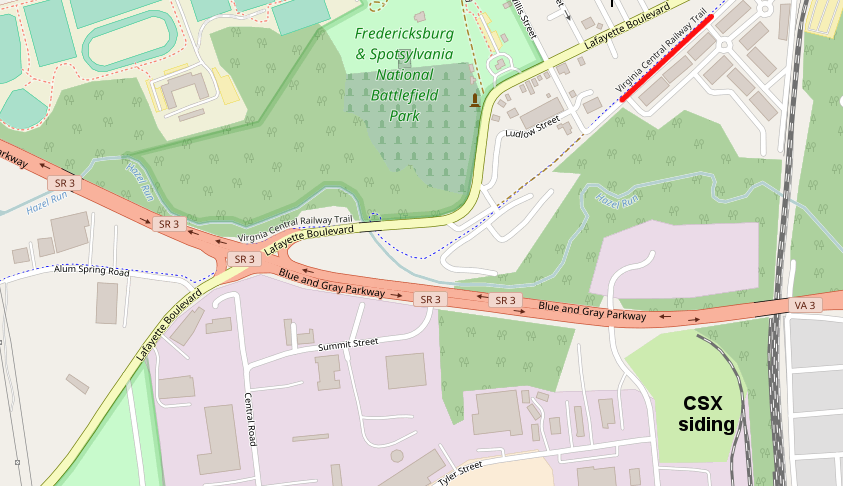
Route 3 construction truncated the link to the Richmond, Fredericksburg and Potomac (now CSX) railroad, and the Virginia Central line is now just a recreational trail
Source: ESRI, ArcGIS Online
Fredericksburg and Spotsylvania County plan to convert their parts of the original Fredericksburg and Gordonsville Railroad into a 17-mile trail, going from downtown Fredericksburg to the eastern edge of Orange County.12
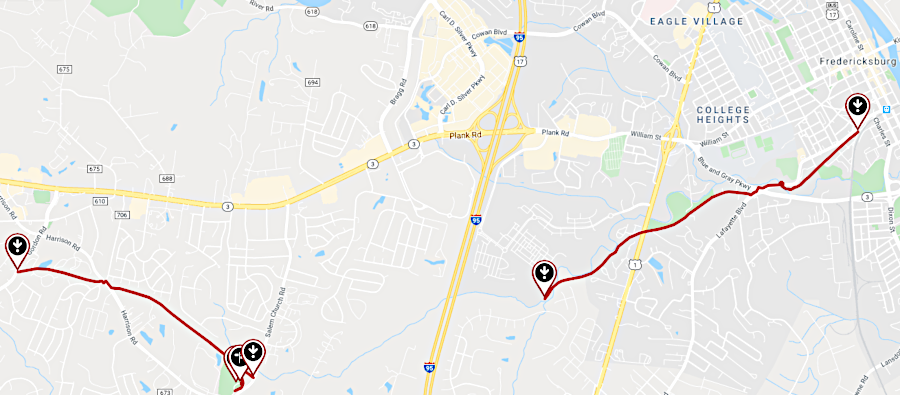
two segments of the Virginia Central Trail, totaling 4 miles, were open in 2019
Source: TrailLink, Virginia Central Railway Trail

the Virginia Central Trail provides views of the historic Virginia Central Railway trail bed
Source: City of Fredericksburg, Parks and Trails
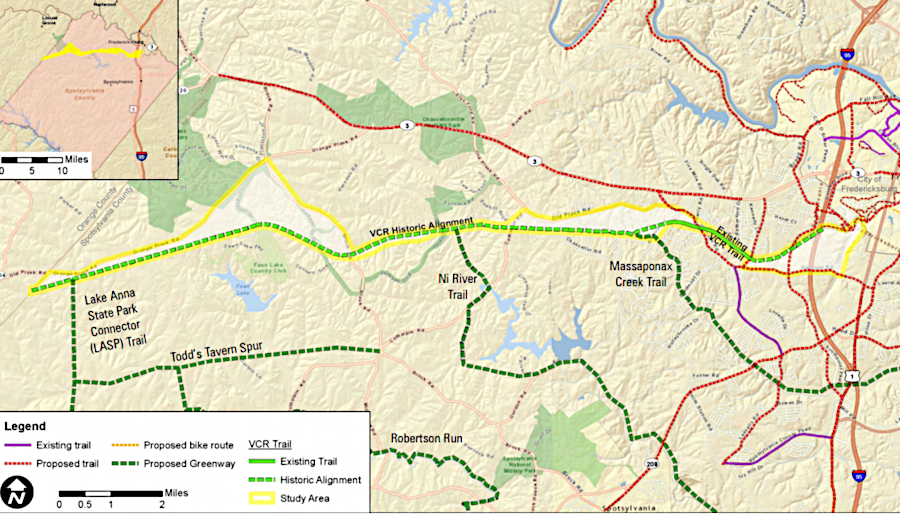
Spotsylvania County and Fredericksburg planned a 17-mile trail from the city's historic core to Orange County
Source: Spotsylvania County, Virginia Central Railway Trail Design Guidelines (Figure 1.1)
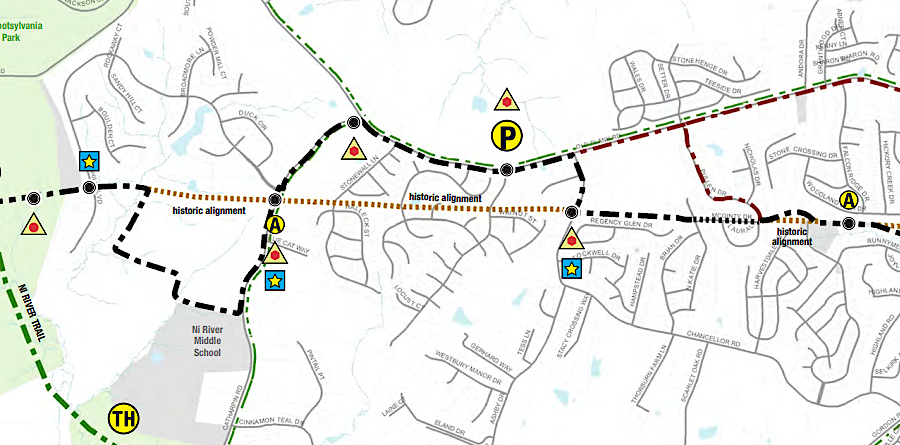
part of the Virginia Central Trail was offset from the historic route, due to modern development
Source: Spotsylvania County, Virginia Central Railway Trail Design Guidelines (p.6)
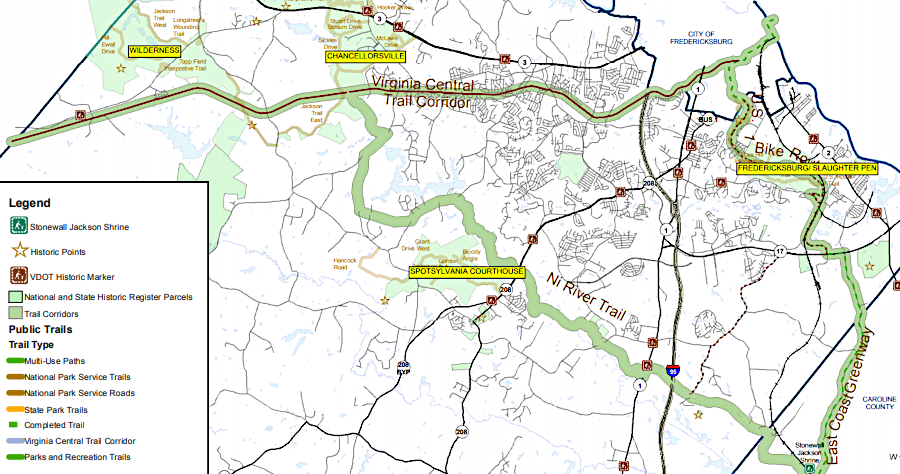
the Virginia Central Trail is part of the Spotsylvania Battlefields Loop
Source: Spotsylvania County, Spotsylvania County, Virginia, Trailways Master Plan (Map 4)
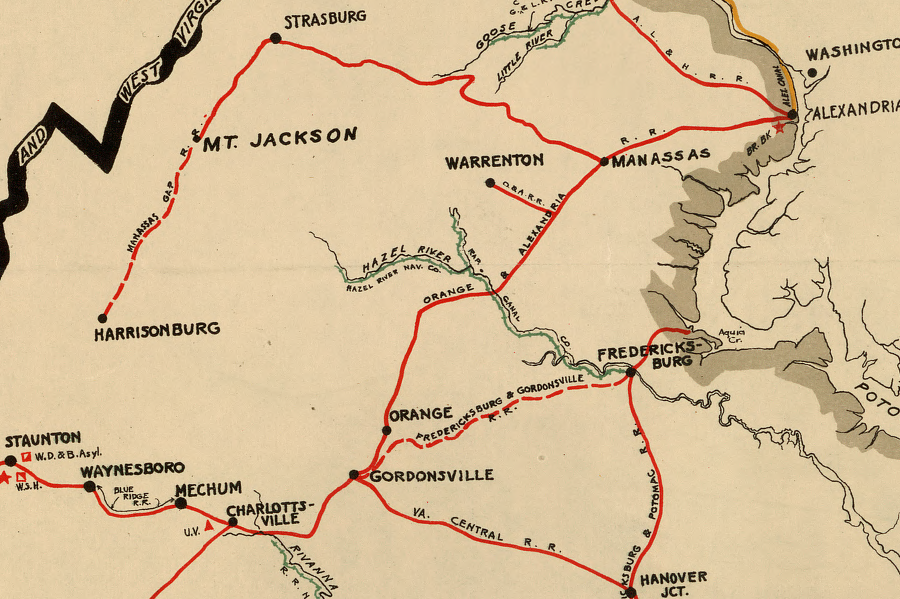
the Fredericksburg and Gordonsville was planned, but not built, in 1861
Source: Library of Congress, Map showing the location of railroads, canals, navigation projects and public institutions in which the Commonwealth of Virginia had invested money as of date January 1st. 1861
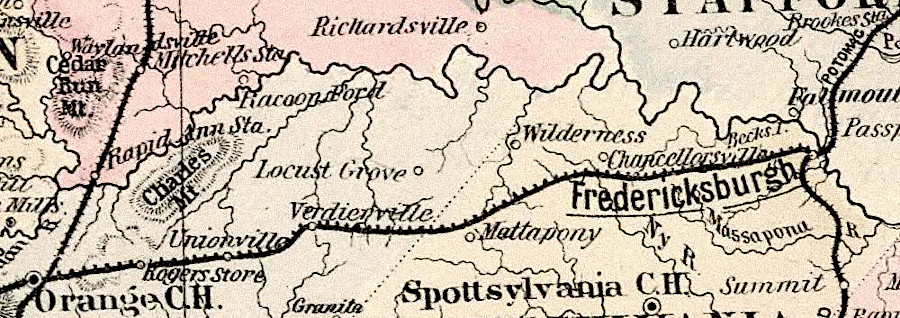
the Potomac, Fredericksburg & Piedmont Railroad was a narrow gauge railroad in 1877
Source: David Rumsey Historical Map Collection, Virginia and West Virginia (The National Atlas Containing Elaborate Topographical Maps Of The United States And The Dominion of Canada, by O. W. Gray, 1877)
1. Ames W. Williams, "Virginia Central Railway," National Railway Bulletin, Volume 50, Number 1 (1985), pp.4-5, http://vcr.golden.im/images/NRBarticle.pdf; "Potomac, Fredericksburg & Piedmont Railroad Company," Annual Report, Virginia, Railroad Commissioner, 1898, p.115, https://books.google.com/books?id=mCUaAQAAIAAJ (last checked June 2, 2020)
2. "Death on the Virginia Central," Spotsylvania Memory, November 24, 2014, http://spotsylvaniamemory.blogspot.com/2014/11/death-on-virginia-central.html; "Virtual Tour Stop, Catharine Furnace," Fredericksburg & Spotsylvania National Military Park, https://www.nps.gov/frsp/learn/photosmultimedia/catharinefurnace.htm (last checked February 1, 2017)
3. "Battle of Chancellorsville History: The Flank Attack," Fredericksburg & Spotsylvania National Military Park, https://www.nps.gov/frsp/learn/historyculture/cvillehist-flank.htm; "Battle of Chancellorsville," Fredericksburg & Spotsylvania National Military Park, https://www.nps.gov/frsp/learn/historyculture/chist.htm (last checked February 1, 2017)
4. "History of the Battle of the Wilderness," Fredericksburg & Spotsylvania National Military Park, https://www.nps.gov/frsp/learn/historyculture/wildspot.htm (last checked February 1, 2017)
5. Ames W. Williams, "Virginia Central Railway," National Railway Bulletin, Volume 50, Number 1 (1985), p.6, http://vcr.golden.im/images/NRBarticle.pdf (last checked February 1, 2017)
6. Robert Hodge, "The Narrow Gauge Railroad," Fredericksburg Times, February, 1978, http://www.librarypoint.org/narrow_gauge_railroad; "The Potomac, Fredericksburg, and Piedmont Railroad (PFP)," The New O&A Railroad, November 15, 2013, http://thenewoanda.weebly.com/blog/thepotomac-fredericksburg-and-piedmont-railroad-pfp (last checked February 1, 2017)
7. The Royal Land Com'y of Virginia, Clemmitt & Jones, 1877, pp.2-3, p.15, pp.17-18, https://books.google.com/books?id=9K9AAAAAYAAJ (last checked February 2, 2017)
8. Ames W. Williams, "Virginia Central Railway," National Railway Bulletin, Volume 50, Number 1 (1985), p.6, http://vcr.golden.im/images/NRBarticle.pdf (last checked February 1, 2017)
9. "Orange to Fredericksburg," Abandoned Rails, http://www.abandonedrails.com/Orange_to_Fredericksburg; Robert Hodge, "The Narrow Gauge Railroad," Fredericksburg Times, February, 1978, http://www.librarypoint.org/narrow_gauge_railroad; "Death on the Virginia Central," Spotsylvania Memory, November 24, 2014, http://spotsylvaniamemory.blogspot.com/2014/11/death-on-virginia-central.html(last checked February 1, 2017)
10. Ames W. Williams, "Virginia Central Railway," National Railway Bulletin, Volume 50, Number 1 (1985), pp.10-15, http://vcr.golden.im/images/NRBarticle.pdf; "Boxcar Collapse Proves Costly Lesson for Many," Washington Post, August 20, 1978, https://www.washingtonpost.com/archive/business/1978/08/20/boxcar-collapse-proves-costly-lesson-for-many/229218b2-22b2-4143-b0ff-db625cd17adb/?utm_term=.bfb4b45ad9ae (last checked February 1, 2017)
11. "The OTHER Va. Central Ry., Fredericksburg 1967?," post by Alan Maples in Railway Preservation News, February 2, 2013, http://www.rypn.org/forums/viewtopic.php?f=1&t=34477&view=previous (last checked February 1, 2017)
12. "Virginia Central Railway Trail Design Guidelines," Spotsylvania County, 2012, p.3, https://www.spotsylvania.va.us/DocumentCenter/View/2143/Virginia-Central-Rail-Trail-Study-PDF (last checked October 31, 2019)
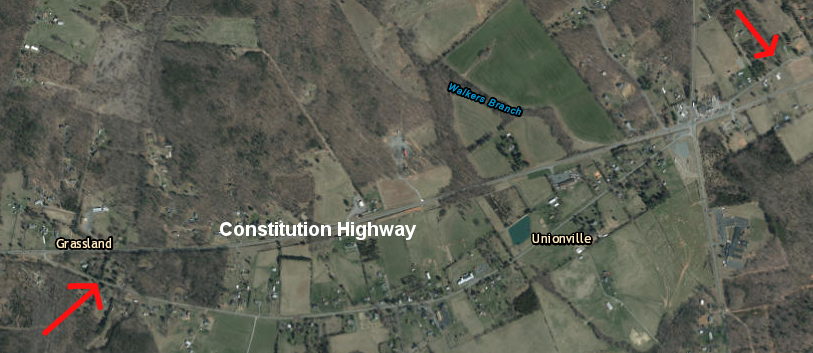
the route of the former Potomac, Fredericksburg & Piedmont Railroad is visible in Orange County on either side of US 20 (Constitution Highway)
Source: ESRI, ArcGIS Online
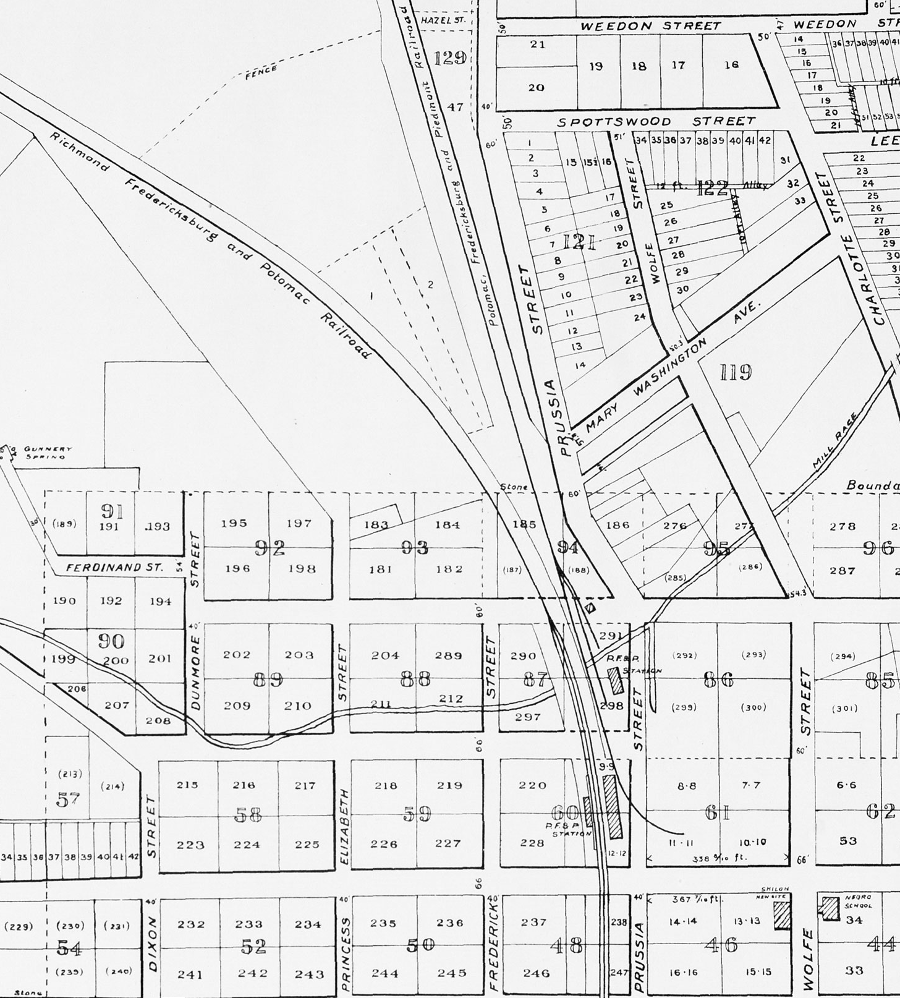
the narrow gauge Potomac, Fredericksburg & Piedmont Railroad (PF&P) ended next to the standard gauge Richmond, Fredericksburg and Potomac (RF&P) Railroad
Source: City of Fredericksburg Maps, 1890 Fredericksburg Map
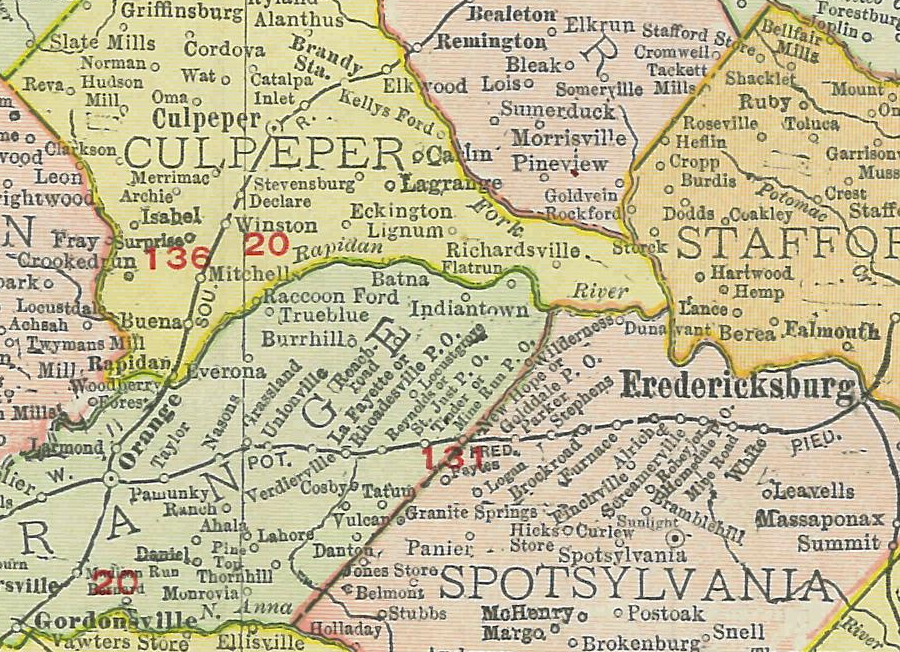
there were multiple stations along the Potomac, Fredericksburg & Piedmont Railroad in 1913
Source: National Archives, The Library Atlas of the World; Volume 1: United States (1913)